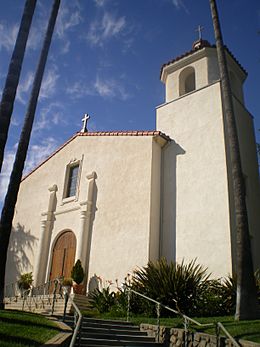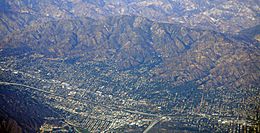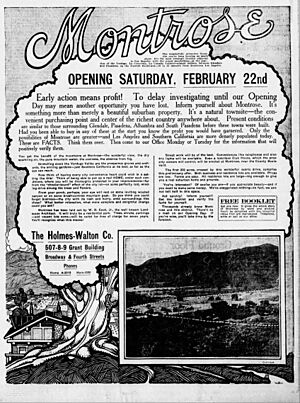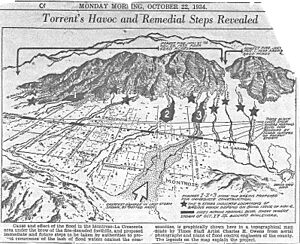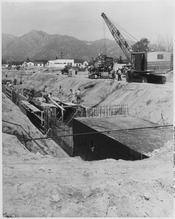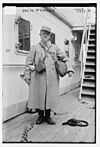La Crescenta-Montrose, California facts for kids
Quick facts for kids
La Crescenta-Montrose, California
|
|
|---|---|
|
Top: Holy Redeemer Catholic Church; Bottom: Mt. Lukens
|
|
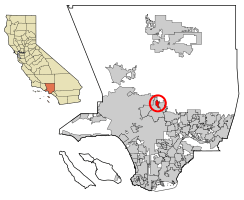
|
|
| Country | |
| State | |
| County | |
| Area | |
| • Total | 3.437 sq mi (8.902 km2) |
| • Land | 3.426 sq mi (8.873 km2) |
| • Water | 0.011 sq mi (0.029 km2) 0.32% |
| Elevation | 1,540 ft (469.392 m) |
| Population
(2010)
|
|
| • Total | 19,653 |
| • Density | 5,718.1/sq mi (2,207.71/km2) |
| Time zone | UTC−8 (PST) |
| • Summer (DST) | UTC−7 (PDT) |
| ZIP Codes |
91214 (La Crescenta)
91020 (Montrose) |
| Area code(s) | 747 and 818 |
| FIPS code | 06-39045 |
La Crescenta-Montrose () is a community in Los Angeles County, California. It's not an official city, but it's a busy place where many people live.
This area is surrounded by other towns. To the south and west, you'll find Glendale. To the east is La Cañada Flintridge. And to the north, there's the beautiful Angeles National Forest.
In 2020, about 19,997 people lived in La Crescenta-Montrose. This community covers about 3.4 square miles (8.9 square kilometers).
Contents
- Exploring La Crescenta-Montrose: Geography
- Who Lives Here? Demographics
- Learning in La Crescenta-Montrose: Education
- A Look Back: History of La Crescenta-Montrose
- Fun Facts: La Crescenta-Montrose in Pop Culture
- Local News: Media
- Getting Around: Transportation
- Historical Places to Visit
- Images for kids
- See also
Exploring La Crescenta-Montrose: Geography
La Crescenta-Montrose is located in a special area called the Crescenta Valley. It also includes parts of the northwestern San Rafael Hills and northeastern Verdugo Mountains.
The community has natural borders. The San Gabriel Mountains and Angeles National Forest are to the north. La Cañada Flintridge is to the east. The Verdugo Mountains and central Glendale are to the south. To the northwest, you'll find the Sunland-Tujunga area of Los Angeles.
The Foothill Freeway (I-210) runs through the southern part of La Crescenta-Montrose. This makes it easy to travel to other parts of California.
Who Lives Here? Demographics
This section shares information about the people living in La Crescenta-Montrose. This data comes from official counts called the U.S. Census.
Population Changes Over Time
| Historical population | |||
|---|---|---|---|
| Census | Pop. | %± | |
| 1970 | 19,594 | — | |
| 1980 | 16,531 | −15.6% | |
| 1990 | 16,968 | 2.6% | |
| 2000 | 18,532 | 9.2% | |
| 2010 | 19,653 | 6.0% | |
| sources: | |||
2010 Census Snapshot
In 2010, the population of La Crescenta-Montrose was 19,653 people. Most people lived in homes, not in group housing.
There were 7,088 households. About 38% of these homes had children under 18. Many homes were families, including married couples. The average household had about 2.77 people.
The community has people of all ages. About 23.5% were under 18. About 12.4% were 65 or older. The average age was around 41.6 years old.
Most homes (64.4%) were owned by the people living in them. The rest were rented. The median income for a household was $89,375. This means half of the households earned more, and half earned less. About 7.4% of the population lived below the poverty line.
2000 Census Snapshot
In 2000, there were 18,532 people living here. The average household size was 2.66 people.
About 26.5% of the population was under 18. About 11.4% were 65 or older. The median age was 39 years.
The median income for a household was $60,089. For families, it was $69,381. About 5.3% of the population lived below the poverty line.
Comparing La Crescenta-Montrose to Nearby Areas
In 2009, a study by the Los Angeles Times looked at different neighborhoods. It found that La Crescenta-Montrose had a high percentage of Asian and white residents compared to the county average.
The median income of $82,693 was also high for the county. Many residents (40.8%) aged 25 and older had a four-year college degree. This was also high for the county.
The community had fewer single-parent households (8.8%) than the county average. Also, a high percentage of residents were veterans who served during the Vietnam War.
| Tujunga | La Crescenta- Montrose |
Glendale | La Cañada Flintridge |
Pasadena | |
|---|---|---|---|---|---|
| Population | 26,527 | 18,507 | 195,047 | 20,381 | 134,941 |
| White | 61% | 66% | 54% | 71% | 39% |
| Latino | 26% | 10% | 20% | 5% | 33% |
| Asian | 7% | 20% | 16% | 20% | 10% |
| Black | 2% | 1% | 1% | 1% | 14% |
| Household income | $58,001 | $82,693 | $57,112 | $148,996 | $62,825 |
| College degree | 22% | 41% | 32% | 64% | 42% |
| Median age | 36 | 38 | 37 | 41 | 34 |
| Single parents | 14% | 9% | 9% | 7% | 13% |
| Veteran | 10% | 11% | 6% | 11% | 8% |
| Foreign born | 30% | 28% | 54% | 19% | 32% |
| Where? | Mexico, Iran |
South Korea, Iran |
Armenia, Mexico |
South Korea, Iran |
Mexico, Philippines |
| Ethnic diversity for L.A. County |
Moderate | Average | High | Moderate | Average |
| Home ownership | 55% | 65% | 38% | 90% | 46% |
Learning in La Crescenta-Montrose: Education
Schools in La Crescenta-Montrose are part of the Glendale Unified School District. This district helps manage many schools in the area.
Elementary Schools
- La Crescenta Elementary School
- Dunsmore Elementary School
- John C. Fremont Elementary School (Glendale)
- Abraham Lincoln Elementary School
- Monte Vista Elementary School
- Mountain Avenue Elementary School
- Valley View Elementary School
Middle Schools
- Rosemont Middle School
High Schools
- Crescenta Valley High School
- Anderson W. Clark Magnet High School
Other Schools
- Verdugo Academy (for students from kindergarten to 12th grade)
- Options For Youth Public Charter Schools (for students from 7th to 12th grade)
Private Schools
- Armenian Sisters' Academy (kindergarten prep to 8th grade)
- Chamlian Armenian School (kindergarten prep to 8th grade)
- Holy Redeemer-St. James Catholic School (kindergarten prep to 8th grade)
- St. Monica Academy (1st to 12th grade)
- Montrose Christian Montessori School (preschool to 6th grade)
A Look Back: History of La Crescenta-Montrose
The land where La Crescenta-Montrose now stands was once home to the Tongva people. Later, in 1843, it became part of a large land grant called Rancho La Cañada. This grant was given by the governor to a teacher named Ygnacio Coronel.
The name "La Crescenta" was chosen in 1888. An early settler, Benjamin B. Briggs, saw three crescent-shaped hills. This gave him the idea for the name. "Montrose" was picked in 1913 after a contest for a new housing area.
The Great Flood of 1934
In November 1933, big wildfires burned in the San Gabriel mountains. These mountains are right above La Crescenta, La Cañada, and Montrose. After the fires, in late December, heavy winter storms brought 12 inches (300 mm) of rain. On New Year's Eve, even more rain caused serious flooding.
Around midnight, hillsides in the mountains collapsed. Millions of tons of mud and debris rushed down into the Crescenta Valley neighborhoods.
More than 400 homes were destroyed in La Cañada, La Crescenta, Montrose, and Tujunga. Many people lost their lives, and hundreds lost their homes. Some families were completely wiped out. The mudslides traveled all the way to the Verdugo Wash.
Parts of Foothill Boulevard were buried under 12 feet (3.7 m) of mud and rocks. On Montrose Avenue, cars were completely covered by the mud. Miles of Honolulu Boulevard were filled with several feet of sand and silt.
After this terrible disaster, engineers built a special flood control system. This system includes catch basins and concrete storm drains. It was designed to prevent such a disaster from happening again.
The flood was remembered in a song by Woody Guthrie called "Los Angeles New Year's Flood." A small monument was dedicated on January 1, 2004. It honors the victims of the flood and marks its 75th anniversary. The monument is located at Rosemont and Fairway avenues in Montrose.
Fun Facts: La Crescenta-Montrose in Pop Culture
La Crescenta-Montrose has appeared in some interesting ways in popular culture.
In 2012, a black bear became famous for visiting the area. It would wander from the Angeles National Forest into homes, looking for food. It especially liked Costco meatballs and tuna! The bear was safely returned to the forest. Someone even made a Twitter account from the bear's point of view, called "GlenBearian."
The historic 1946 La Crescenta Motel is a popular filming location. It's been used in many movies and TV shows. You might have seen it in shows like Glee, Criminal Minds, Mad Men, and True Blood.
Rockhaven Sanitarium opened in 1923. It was built entirely of rock. It became known as the "Screen Actors' Sanitarium" because some famous people stayed there. This included Billie Burke and Gladys Baker, who was Marilyn Monroe's mother. The property was bought by the City of Glendale in 2008 and is being considered for new uses.
In 1996, actress Margot Kidder was found in Glendale. She had been trying to walk 12 miles (19 km) from downtown Los Angeles to a friend's home in La Crescenta. She was then taken to a hospital for care.
Local News: Media
La Crescenta and the Crescenta Valley area have their own local newspapers. These include the Crescenta Valley Weekly newspaper and the Glendale News Press.
Getting Around: Transportation
There are several ways to travel to and from La Crescenta-Montrose.
The Amtrak Thruway bus service (Route 19) offers connections twice a day. You can catch it at Lowell and Honolulu Avenues. It connects to Bakersfield to the north and San Bernardino to the east.
The closest Amtrak train station is in Glendale.
The Metro 90 bus connects La Crescenta to the North Hollywood station and downtown Los Angeles.
Historical Places to Visit
La Crescenta-Montrose has many interesting historical spots.
- St. Luke's of the Mountains Episcopal Church was designed by artist Seymour Thomas in 1924. It's made of natural stone from the valley. It looks like a beautiful old church you might find in northern Europe. It's at 2563 Foothill Boulevard.
- Le Mesnager Barn is a stone barn built in 1911 by George Le Mesnager. He was a French patriot. He used the barn to store grapes from his vineyards. These grapes were used to make wine in downtown Los Angeles. The City of Glendale owns it now and plans to make it a nature and history center. It's in Deukmejian Wilderness Park.
- Ananda Ashram is one of two American ashrams founded by Swami Paramananda, an Indian teacher. It was started in 1923 and is located at the top of Pennsylvania Avenue, near Deukmejian Wilderness Park.
- The La Crescenta Woman's Club began in 1911. They built their clubhouse in 1925. This building has been a social hub for the valley for a long time. It's at 4004 La Crescenta Avenue.
- Sparr Heights Community Center was built in 1922 by William S. Sparr. It was first a real estate office. Later, it was given to the City of Glendale and became a community meeting place and senior center. It's at 1613 Glencoe Way.
- La Crescenta Elementary School was first built in 1887. A wooden schoolhouse was built at its current site in 1890. The building you see today was built in 1948.
- The Old School Bell first rang for students in 1890. It was put away for many years but was re-hung in 1976. It's in front of La Crescenta Elementary School. Graduating students ring it once a year in June.
- La Crescenta Presbyterian Church is a striking church built in 1923. This is one of the oldest church groups in the valley. They first met in the 1880s. It's located at 2902 Montrose Avenue.
Images for kids
See also
 In Spanish: La Crescenta-Montrose para niños
In Spanish: La Crescenta-Montrose para niños


